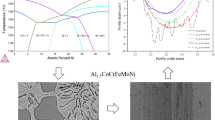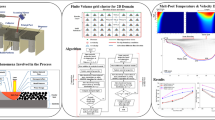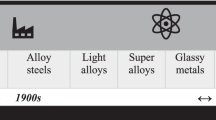Abstract
The simulation of casting processes demands accurate information on thermophysical properties for selected alloys to properly feed the mathematical models. One of such properties is the viscosity of pure liquid metals and alloys, which can be either found in the literature as experimental data or to be calculated by theoretical models. Nevertheless, a considerable discrepancy between experimental data and simulated results is frequently observed for some pure metals, as high as twice the experimental measured values. Several models can be found in the literature, such as those in the form of Arrhenius-type equations, which depend on the availability of experimental data with a view to permitting the apparent activation energy and the pre-exponential constant parameters to be determined. Furthermore, models based on Andrade’s equation and its extensions, to deal with the apparent activation energy and the free volume concepts, are generally dependent only on thermodynamic data, that is, molar weight, molar volume, Gibbs energy of viscous flow activation, Gibbs energy and enthalpy of formation, and the molar fractions of the alloy components. In this paper, an extension of Takahira’s model for pure liquid metals is proposed, which permits to deal with the viscosity of liquid multicomponent alloys. Comparisons are made among simulations provided by an Arrhenius-type equation, Kaptay’s and Takahira’s models for pure metals, as well as among an Arrhenius-type equation, Kaptay’s model and the present approach for multicomponent alloys. The simulated results are plotted against experimental viscosity data from the literature for pure liquid metals (Al, Cu, Si and Mg) and for ternary and quaternary commercial Al-based alloys. The proposed approach for multicomponent alloys is shown to agree well with the experimental scatters and with Kaptay’s model for all examined cases.
Similar content being viewed by others
References
Cheng, J., Gröbner, J., Hort, N., Schmid-Fetzer, R.: Measurement and calculation of the viscosity of metals—a review of the current status and developing trends. Meas. Sci. Technol. 25, 062001 (2014)
Bakhtiyarov, S.I., Overfelt, R.A.: Measurement of liquid metal viscosity by rotational technique. Acta Mater. 47, 4311–4319 (1999)
Dinsdale, A.T., Quested, P.N.: The viscosity of aluminium and its alloys—a review of data and models. J. Mater. Sci. 39, 7221–7228 (2004)
Brooks, R.F., Dinsdale, A.T., Quested, P.N.: The measurement of viscosity of alloys—a review of methods, data and models. Meas. Sci. Technol. 16, 354–362 (2005)
da Andrade, E.N.C.: A theory of the viscosity of liquids—part I. Philos. Mag. 17, 497–511 (1934)
Battezati, L., Greer, A.L.: The viscosity of liquid metals and alloys. Acta Metall. 37, 1791–1802 (1989)
Iida, T., Shiraishi, Y.: Chapter 4-Viscosity. In: Kawai, Y., Shirashi, Y. (eds.) Handbook of Physico-Chemical Properties at High Temperatures. Iron and Steel Institute, Japan (1988)
Hirai, M.: Estimation of viscosities of liquid alloys. ISIJ 33(2), 281–285 (1993)
Hildebrand, J.H.: Viscosity and Diffusivity: A Predictive Treatment. Wiley, New York (1977)
Mehrota, A.K.: A generalized viscosity equation for pure heavy hydrocarbons. Ind. Eng. Chem. Res. 30(6), 1367–1372 (1991)
Walther, C.: The evaluation of viscosity data. Erdol Teer 7, 382–384 (1931)
Chhabra, R.P., Tripathi, A.: A correlation for the viscosity of liquid metals. High Temp. High Press. 25, 713–718 (1993)
Kaptay, G.: A unified equation for the viscosity of pure liquid metals. Z. Metallkd. 96, 1–8 (2005)
Zivkovic, D., Manasijevic, D.: An optimal method to calculate the viscosity of simple liquid ternary alloys from the measured binary data. CALPHAD 29, 312–316 (2005)
Kucharski, M.: The viscosity of multicomponent systems. Z. Metallkd. 77, 393–396 (1986)
Kaptay, G.: A new equation to estimate the concentration dependence of the viscosity of liquid metallic alloys from the heat of mixing data. In: Proceedings of microCAD 2003 Conference, Section Metallurgy, University of Miskolc, Hungary, 23–28 2003
Zhong, X.M., Liu, Y.H., Chou, K.C., Lu, X.G., Zivkovic, D., Zivkovic, Z.: Estimating ternary viscosity using the thermodynamic geometric model. J. Phase Equilib. 24, 7–11 (2003)
Singh, R.N., Nadan, R., Sommer, F.: Viscosity of liquid alloys: generalization of Andrade’s equation. Monatsh. Chem. 143, 1235–1242 (2012)
Jeyakumar, M., Hamed, M., Shankar, S.: Rheology of liquid metals and alloys. J. Non-Newton. Fluid Mech. 166, 831–838 (2011)
Solek, K., Korolczuk-Hejnak, M., Slezak, W.: Viscosity measurement for modeling of continuous steel casting. Arch. Metall. Mater. 57, 333–338 (2012)
Budai, I., Benkö, M.Z., Kaptay, G.: Comparison of different theoretical models to experimental data on viscosity of binary liquid alloys. Mater. Sci. Forum 537–538, 489–496 (2007)
Moelwyn-Hughes, E.A.: Physikalische Chemie. Thieme, Stuttgart (1970)
Iida, T., Ueda, M., Morita, Z.: On the excess viscosity of liquid alloys and the atomic interaction of their constituents. Tetsu-to-Hagane 62, 1169–1178 (1976)
Kozlov, L.Y., Romanov, L.M., Pod’yachev, A.P., Petrov, N.N., Kostygova, O.V.: Calculation of the viscosity of multicomponent iron- and nickel-base melts. Izv. Vyssh. Uchebn. Zaved. Chern. Metall. 5, 1–4 (1982)
Seetharaman, S., Du, S.C.: Estimation of the viscosities of binary metallic melts using Gibbs energies of mixing. Metall. Mater. Trans. 25B, 589–595 (1994)
Takahira, N.: Influence of enthalpy changes on the temperature dependency of the viscosity of pure liquid metals. ISIJ Int. 55(10), 2247–2251 (2015)
Sato, Y., Sugisawa, K., Aoki, D., Yamamura, T.: Viscosities of Fe–Ni, Fe–Co and Ni–Co binary melts. Meas. Sci. Technol. 16, 363–371 (2005)
Zhang, F., Du, Y., Liu, S., Jie, W.: Modeling of the viscosity in the Al–Cu–Mg–Si system: database construction. CALPHAD 49, 79–86 (2015)
Nascimento, F.C., Paresque, M.C.C., Castro, J.A., Jácome, P.A.D., Garcia, A., Ferreira, I.L.: Application of computational thermodynamics to the determination of thermophysical properties as a function of temperature for multicomponent Al-based alloys. Thermochim. Acta 619, 1–7 (2015)
Ferreira, D.J.S., Bezerra, B.N., Collyer, M.N., Garcia, A., Ferreira, I.L.: The use of computational thermodynamics for the determination of surface tension and Gibbs–Thomson coefficient of multicomponent alloys. Contin. Mech. Therm. 30, 1145–1154 (2018)
Kobatake, H., Schmitz, J., Brillo, J.: Density and viscosity of ternary Al–Cu–Si alloys. J. Mater. Sci. 49, 3541–3549 (2014)
Sato, Y.: Report to the Ministry of Economy, Trade and Industry (METI), Japan (2004)
Mills, K.C.: Recommended Thermophysical Properties for Selected Commercial Alloys. Woodhead Publishing Series in Metals and Surface Engineering (2002)
Arsent’ev, P.P., Polyakova, K.I.: Izv Vyssh, Uchebn Zaved. Tsvetn. Metall. 51, 5 (1977)
Gebhardt, E., Becker, M., Dorner, S.: Effect of alloying additions on the viscosity of aluminum. Aluminum 31, 315–321 (1955)
Kehr, M., Hoyer, W., Egry, I.: A new high-temperature oscillating cup viscometer. Int. J. Thermophys. 28, 1017–1025 (2007)
Wang, D., Overfelt, R.A.: Oscillating cup viscosity measurements of aluminum alloys: A201, A319 and A356. Int. J. Thermophys. 23, 1063–1076 (2002)
Lihl, F., Nachtigall, E., Schwaiger, A.: Viskositätsmessungen an binären Legierungen des Aluminiums mit Silizium, Zink, Kupfer und Magnesium. Z. Metallkd. 59, 213–219 (1968)
Culpin, M.F.: The viscosity of liquid magnesium and liquid calcium. Proc. Phys. Soc. 70, 1079–1086 (1957)
Acknowledgments
The authors acknowledge the financial support provided by FAPERJ (The Scientific Research Foundation of the State of Rio de Janeiro), CAPES and CNPq (National Council for Scientific and Technological Development).
Author information
Authors and Affiliations
Corresponding author
Additional information
Communicated by Andreas Öchsner.
Publisher's Note
Springer Nature remains neutral with regard to jurisdictional claims in published maps and institutional affiliations.
Rights and permissions
About this article
Cite this article
Ferreira, I.L., de Castro, J.A. & Garcia, A. On the prediction of temperature-dependent viscosity of multicomponent liquid alloys. Continuum Mech. Thermodyn. 31, 1369–1385 (2019). https://doi.org/10.1007/s00161-019-00753-7
Received:
Accepted:
Published:
Issue Date:
DOI: https://doi.org/10.1007/s00161-019-00753-7




